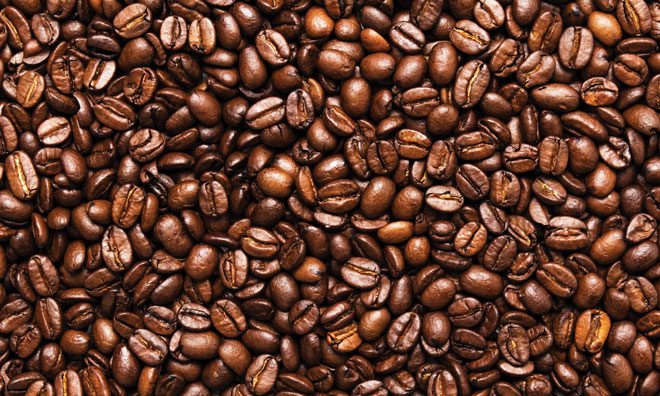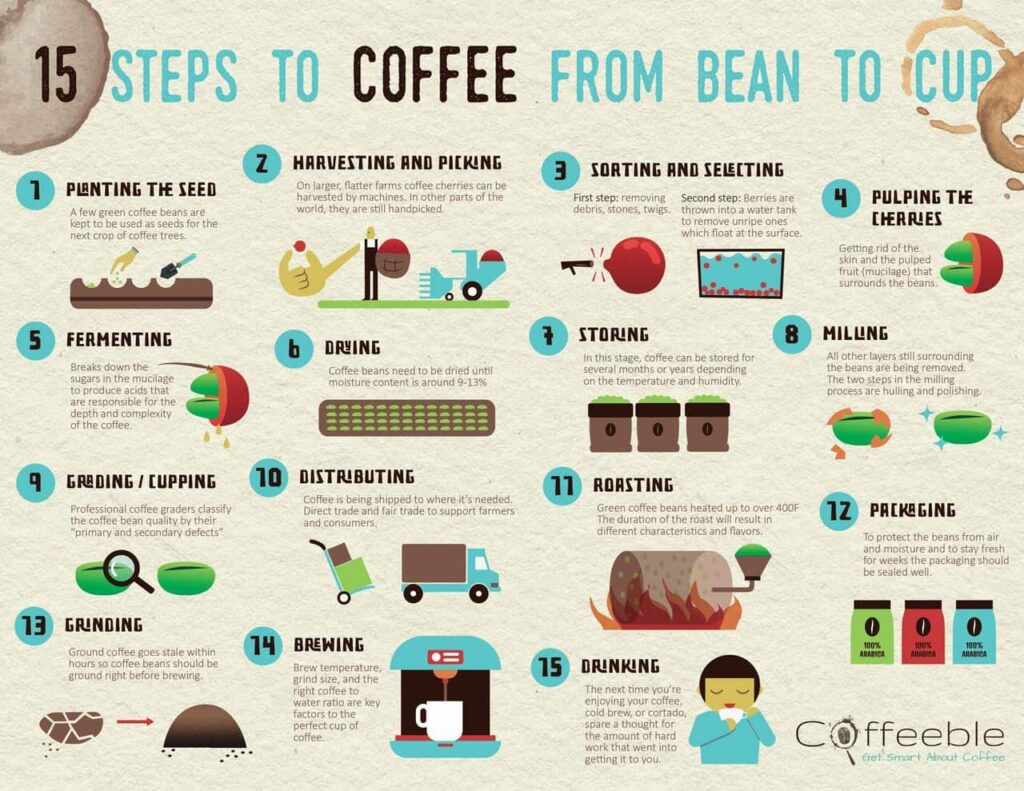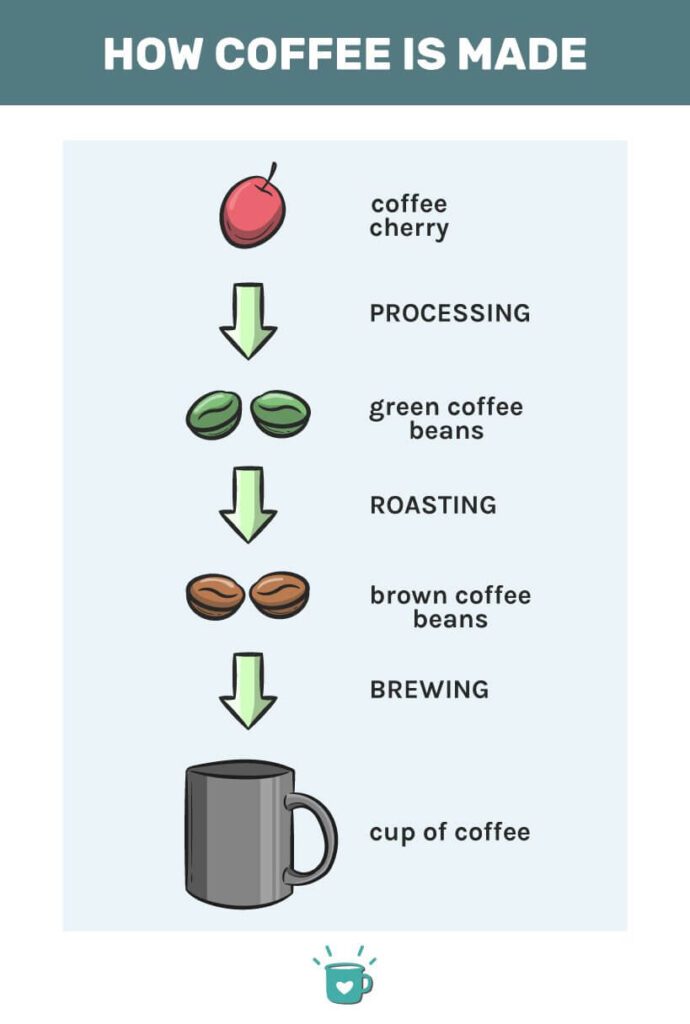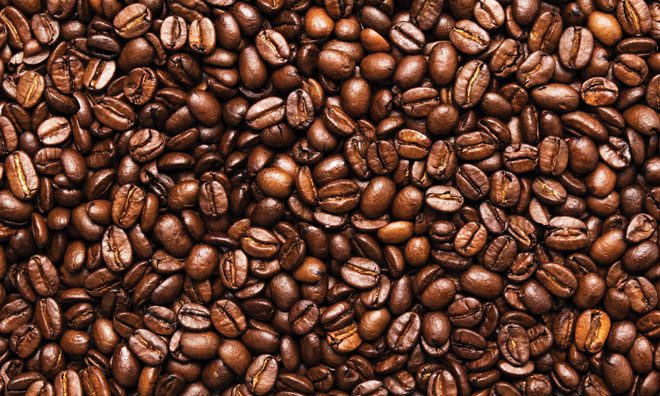Have you ever wondered how that cup of coffee you enjoy every morning makes its way to your cup?
From the tiny coffee beans harvested from coffee plants to the aromatic and flavorful beverage that fuels our mornings, the journey of coffee is a complex and fascinating.
In this article, we will explore coffee’s intricate process before it reaches our cups, revealing the various stages, techniques, and methods involved in bringing us the perfect cup of joe.
Get ready to embark on a journey through the coffee processing world!
Harvesting
Picking the cherries
The process of bringing delicious coffee to your cup starts with the harvesting of the coffee cherries. Coffee cherries typically take months to ripen after flowering, and it is crucial to determine the perfect time for picking.
Skilled coffee farmers know cherries must be picked at their peak ripeness to ensure the best possible flavor.
The most common method of picking coffee cherries is selective picking. This method involves harvesting only the fully ripe cherries by hand, which is labor-intensive.
Skilled workers meticulously scan the coffee trees and carefully select the cherries ready for harvest. Selective picking ensures that only the ripest cherries are collected, producing a high-quality coffee.
Processing methods
After the cherries have been carefully picked, they must undergo processing to remove the outer layers and extract the coffee beans. There are three primary processing methods: wet, dry, and semi-washed.
Wet processing, also known as the washed process, involves water removing the outer skin and pulp from the cherries. This method produces a clean and bright cup of coffee, often with fruity or floral flavor notes. The cherries are sorted and then placed into fermentation tanks, soaked in water for a specific period to remove the mucilage. After fermentation, the beans are washed and dried.
Dry processing, or natural processing, is another method where the cherries are spread out on drying beds or patios to dry naturally in the sun. This process allows the cherries to dry with intact pulp, infusing the beans with fruity and wine-like flavors. The outer layers are removed once the cherries are dry to reveal the coffee beans.
Semi-washed processing, commonly known as honey processing, combines wet and dry processing elements. With this method, the cherries are de-pulped like in a wet process, but the mucilage is left on during drying. The resulting coffee often has a balanced flavor profile, with characteristics from both washed and natural processing.
Fermentation
Fermentation tanks
During the wet processing method, fermentation is crucial to create the desired flavors in the coffee beans. This stage occurs in fermentation tanks, where the cherries are soaked in water for a specific time.
Fermentation tanks are designed to control the oxygen levels and temperature during the fermentation process. The duration of fermentation varies depending on factors such as altitude, climate, and desired flavor profile. Proper fermentation brings out the unique qualities of the coffee, enhancing its aroma, acidity, and overall taste.
Fermentation time and temperature
The time and temperature during fermentation play a significant role in shaping the final flavor of the coffee. Short fermentation times usually result in a cleaner cup with more acidity, while longer fermentation times can produce more prosperous, more complex flavors.
Temperature control is essential during fermentation to prevent the growth of unwanted microorganisms that could negatively impact the coffee’s flavor. Generally, coffee fermentation occurs at room temperature, but some specialty coffee producers experiment with controlled fermentation temperatures to influence flavor development.
Drying
Sun drying
After the coffee cherries have been processed, the coffee beans need to be dried to reduce their moisture content. Sun drying is one of the traditional methods used to dry coffee beans.
The beans are spread out on large drying beds or patios in sun drying, exposed to direct sunlight. The heat from the sun evaporates the moisture, gradually reducing the water content in the beans. This slow and natural drying process allows the beans to develop unique flavors and characteristics.
Sun drying requires proper monitoring and care to avoid over-drying or moisture build-up. The beans must be regularly turned and raked to ensure even drying and prevent mold growth. It is a labor-intensive process that requires patience and expertise to achieve the desired moisture level.
Mechanical drying
In addition to sun drying, mechanical drying methods have been developed to speed up the drying process. These include using mechanical dryers that blow warm air over coffee beans, significantly reducing drying time.
Mechanical drying is efficient, especially in regions with unpredictable weather or high humidity. It allows coffee producers to control and optimize the drying process, ensuring consistency and minimizing the risk of spoilage. However, some argue that mechanical drying can impact the flavor profile of the coffee, as the drying process occurs more rapidly than sun drying.
Milling
Hulling
Once the coffee beans are dried, they undergo the milling process, which involves removing the outer layers to reveal the green coffee beans. The first step in this process is hulling, where the dry parchment layer, the dried husk, and the remaining dried pulp are removed from the beans.
Hulling machines use friction and pressure to strip away the dry parchment layer from the beans. This step is crucial for preparing the beans for further processing, such as roasting and grinding. Proper hulling ensures that the beans are free from unnecessary layers and ready for the following stages of the coffee supply chain.
Polishing
After hulling, some coffee beans undergo a polishing process to remove any remaining silver skin. This step improves the appearance of the beans, giving them a smooth and shiny appearance. Polishing is often optional, and deciding to polish coffee beans depends on the desired market presentation and consumer preferences.
Grading
Grading is essential to the milling process, where coffee beans are sorted according to their size, shape, and density. Grading ensures consistency in quality and helps determine the coffee’s value and potential end-use.
Countries have their grading systems, often based on a number scale or letter grades. Beans that meet specific criteria for size, appearance, and defects are assigned higher grades, indicating higher quality. This grading process helps buyers and consumers make informed decisions when purchasing coffee.
Sorting
Sorting is the final step in the milling process, where the coffee beans are carefully inspected and sorted by hand or machine. This step removes defects or impurities, such as broken or discolored beans, stones, or foreign objects.
Sorting ensures that only the best beans make it to the market, maintaining the desired quality and consistency. Skilled sorters meticulously examine each bean, using their expertise to identify and eliminate any irregularities. This attention to detail guarantees that the coffee you enjoy is of the highest quality.
Roasting
Green coffee
Before coffee beans can be brewed and enjoyed, they go through the roasting process. Green coffee refers to the unroasted coffee beans that have completed the earlier processing stages. During the roasting process, the beans acquire their distinctive flavors and aromas.
The green coffee beans’ quality and origin greatly influence the roasted coffee’s final taste. Skilled coffee roasters carefully select the best beans and develop unique roasting profiles to produce desired flavor characteristics.
Roasting process
The roasting process involves applying heat to the green coffee beans to transform them into the familiar brown roasted beans. During roasting, several complex chemical reactions occur within the beans, producing volatile compounds contributing to the coffee’s aroma and flavor.
Roasters can adjust parameters such as temperature, duration, and airflow to achieve specific roast profiles. Light roasts are typically roasted at lower temperatures for a shorter duration, resulting in a more acidic and delicate flavor. Medium and dark roast profiles are achieved by gradually increasing the heat, extending the roasting time, developing deeper flavors, and reducing acidity.
Roast levels
Coffee beans can be roasted to different levels, creating diverse flavors and characteristics. The roast level determines the color and oiliness of the beans and the flavor profile.
Expected roast levels include light, medium, and dark roast. Light roasts preserve more of the coffee’s original flavors, highlighting its acidity and the unique characteristics of the beans. Medium roasts balance acidity and body, while dark roasts develop bold flavors with lower acidity and a fuller body.
Roasters and coffee enthusiasts experiment with various roast levels to explore the endless possibilities of flavor and aroma in the coffee beans.
Grinding
Grind size
I was grinding coffee beans just before brewing, which is essential to extracting the maximum flavor from the beans. The grind size plays a significant role in determining the extraction rate and flavor profile during brewing.
Different brewing methods require different grind sizes. For example, espresso machines require a fine grind for the pressurized extraction process, while a coarser grind is better suited for a French press or cold brew. Grinding too fine or too coarse can result in under-extraction or over-extraction, affecting the taste and balance of the brewed coffee.
Grind consistency
Consistency in the grind size is crucial for brewing a consistent and well-balanced cup of coffee. The particles should be uniform in size to ensure even extraction and avoid producing bitter or weak coffee.
Whether manual or electric, coffee grinders strive to achieve a consistent grind size by using adjustable settings and precision mechanisms, Burr grinders are highly recommended for achieving a more consistent grind than blade grinders.
Achieving an appropriate and consistent grind size helps maximize the potential flavors of the coffee beans, allowing you to savor each cup fully.
Brewing
Methods
Brewing methods provide an endless array of possibilities to explore the flavors and characteristics of coffee beans. From traditional methods to modern techniques, each brewing method imparts its unique touch to the final cup.
Some popular brewing methods include drip, pour-over, French press, espresso, and cold brew. Each method involves different water-to-coffee ratios, brewing times, and extraction techniques, resulting in various flavors, strengths, and aromas.
Experimenting with different brewing methods allows you to uncover new dimensions of the coffee’s taste profile, making each brewing experience a delightful adventure.
Brewing equipment
The choice of brewing equipment can significantly impact your coffee brewing experience. The market offers various brewing equipment from simple tools to high-tech gadgets to suit every preference and budget.
Some standard brewing equipment includes coffee makers, espresso machines, pour-over devices, French presses, and AeroPress.
Each equipment type has unique functionality and brewing process, allowing you to customize your brewing experience and achieve your preferred coffee strength and flavor.
Selecting the right brewing equipment ensures you can consistently brew your favorite coffee at home, contributing to an enjoyable and fulfilling coffee-drinking routine.
Packaging
Storage and transportation
Proper storage and transportation methods are crucial to maintain the quality and freshness of the coffee. Coffee beans are sensitive to moisture, light, air, and changes in temperature, which can all degrade the beans’ flavor and aroma.
Coffee is often stored in airtight containers or bags to prevent exposure to oxygen and moisture. Proper storage conditions, such as calm and dark environments, help preserve the beans’ quality for an extended period. During transportation, efforts are made to minimize exposure to external elements that could affect the coffee’s quality.
The coffee supply chain involves careful coordination between producers, exporters, importers, and roasters to ensure that the coffee reaches your cup in the best possible condition, retaining its distinct qualities and flavors.
Packaging materials
Coffee packaging materials play a vital role in preserving the quality and freshness of the beans. Bags or containers must be designed to protect the coffee from oxygen, moisture, and light, which can degrade its flavor over time.
Several packaging options are available, including valve-sealed bags, which release excess carbon dioxide while preventing oxygen from entering. Additionally, specialty coffee brands often focus on sustainable packaging materials, opting for recyclable or biodegradable options to reduce environmental impact.
Investing in quality packaging materials ensures that the coffee you purchase retains its freshness and flavor, providing a delightful experience with every cup.
Conclusion
Final thoughts
From the meticulous cherry-picking to the careful packaging, the coffee supply chain involves numerous stages and processes to bring exceptional coffee to your cup. Skilled farmers, processors, roasters, and coffee professionals collaborate to deliver a high-quality and memorable coffee experience.
Next time you savor your morning coffee, take a moment to appreciate the craftsmanship and dedication that goes into each process step.
The careful selection of cherries, the meticulous processing methods, the art of roasting, and the precision in grinding and brewing – all contribute to the unique and flavorful cup of coffee that brings joy and energy to your day.
Coffee supply chain
The coffee supply chain is a complex network of interactions spanning from coffee farms to coffee shops and homes worldwide. It involves countless individuals dedicated to bringing you the best possible coffee experience.
Coffee cherries are grown and harvested in coffee-producing regions, carefully processed to extract the beans, and then transported to various destinations around the globe. Importers and roasters source and evaluate the beans, utilizing their expertise to unlock the flavors hidden within each batch.
Finally, the coffee reaches the hands of baristas and coffee enthusiasts who skillfully brew the beans, transforming them into rich, aromatic beverages. Each step in the supply chain contributes to the coffee’s final taste, aroma, and quality, making it a collaborative effort to deliver a truly exceptional product.
As a coffee lover, you can appreciate and support this intricate coffee supply chain by exploring different origins, roast profiles, and brewing techniques.
By understanding the complex journey your coffee undertakes before reaching your cup, you can enhance your appreciation of this beloved beverage and the immense dedication and passion that goes into its creation. So, savor every sip and celebrate the remarkable journey of coffee, from the harvest to your cup.



































